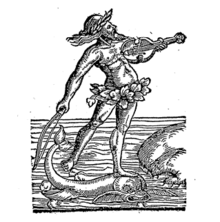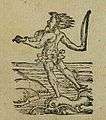Johannes Oporinus
| Johannes Oporinus
Engraving by Theodor de Bry | |
|---|---|
| Born |
25 January 1507 Basel |
| Died |
6 July 1568 (aged 61) Basel |
| Residence | Basel |
| Nationality | Swiss |
| Fields |
printing, medicine, classical philology |
| Institutions | University of Basel |
| Known for |
Publication of Vesalius; first printed Koran amanuensis of Paracelsus |
Johannes Oporinus (original German name: Johannes Herbster or Herbst) (25 January 1507 – 6 July 1568) was a humanist printer in Basel, the son of the painter Hans Herbst.
Life
Johannes Oporinus was born in Basel the son of the painter Hans Herbst. He completed his academic training in Strasbourg and Basel. After working as a teacher in the Cistercian convent of St. Urban, he returned to Basel, where he worked as a proofer in the shop of Johann Froben, the most important Basel printer of the early 16th Century. In addition, he taught at the Basel Latin school from 1526. After 1537 Oporinus taught Greek at the University of Basel. In 1542 he resigned his academic post to devote himself full-time to his printing workshop. In addition, he completed a medical studies and was temporarily famulus to the iconoclastic physician Paracelsus.
Publications
The first edition of the Latin Koran in 1542/43 edited by Theodor Bibliander (the first printed Koran worldwide) from a translation made by Robert of Ketton in Spain between 1142 and 1143 by command of Peter the Venerable caused Oporinus serious difficulties. The Basel city council wanted to prevent the publication but yielded due to the intervention of Martin Luther and Philip Melanchthon. In October 1546 a book on the assassination of the Spanish Protestant Juan Díaz entitled Historia vera de morti sancti viri Ioannis Diazii Hispanics [...] by Claudium Senarclaeum was published by his workshop, which is attributed to Francisco de Enzinas. Oporinus later printed the works on church history by Matthias Flacius Illyricus (Catalogus testium veritatis1556 and 1562) and began the publication of the Magdeburg Centuries (1559–1574) of which only the ages 1–13 were completed.
He made a Latin version of Gesta Danorum in 1534, titled Saxonis Grammatici Danorum Historiae Libri XVI. In addition, his press published numerous polemical theological works, classics, and historiographical works. He died deeply in debt. His manuscript collection and his extensive correspondence are preserved in the Basel University Library.

Significance
His fine knowledge of ancient languages served the quality of consistently correct textual editions of his workshop. Looking at the cover of an Oporinus publication, the printer’s device is striking. It shows the mythological lyre player Arion of Lesbos, which is supported by a Dolphin on the sea. The most important publication of his shop was the anatomical atlas De humani corporis fabrica by the humanist physician Andreas Vesalius (1514–1564), editio princeps in 1543.[1]
- Oporinus' marks
-

-

-

References
- ↑ Kusukawa, Sachiko. "De humani corporis fabrica. Epitome". Cambridge Digital Library. Retrieved 1 August 2016.
Further reading
- Harry Clark (1984), The Publication of the Koran in Latin: A Reformation Dilemma. The Sixteenth Century Journal, Vol.15, No.1, (Spring 1984), pp. 3–12. Available via JSTOR
- Carlos Gilly (2001), Die Manuskripte in der Bibliothek des Johannes Oporinus: Verzeichnis der Manuskripte und Druckvorlagen aus dem Nachlass Oporins anhand des von Theodor Zwinger und Basilius Amerbach erstellten Inventariums. (Schriften der Universitätsbibliothek Basel 3). Schwabe, Basel, ISBN 3-7965-1088-4
- Martina Hartmann (2001), Humanismus und Kirchenkritik. Matthias Flacius Illyricus als Erforscher des Mittelalters. (Beiträge zur Geschichte und Quellenkunde des Mittelalters 19) Thorbecke, Stuttgart, ISBN 3-7995-5719-9
- Martina Hartmann, Arno Mentzel-Reuters (2005), Die Magdeburger Centurien und die Anfänge der quellenbezogenen Geschichtsforschung. Ausstellung. Monumenta Germaniae Historica (MGH), Munich.
- Andreas Jociscus (1569) Oratio De Ortv, Vita, Et Obitv Ioannis Oporini Basiliensis, Typographicoru[m] Germaniæ Principis. Rihelius, Strasbourg (digitized, also contains the Catalogvs Librorvm Per Ioannem Oporinium excusorum)
- Oliver K. Olson (2002) Matthias Flacius and the survival of Luther’s Reform. (Wolfenbütteler Abhandlungen zur Renaissanceforschung 20). Herzog August Bibliothek, Wolfenbüttel, ISBN 3-447-04404-7
- Karl Steiff (1887), "Oporinus, Johannes", Allgemeine Deutsche Biographie (ADB) (in German), 24, Leipzig: Duncker & Humblot, pp. 381–387
- Martin Steinmann (1967) Johannes Oporinus. Ein Basler Buchdrucker um die Mitte des 16. Jahrhunderts. (Basler Beiträge zur Geschichtswissenschaft 105). Helbing & Lichtenhahn, Basel.
- Martin Steinmann (1969), Aus dem Briefwechsel des Basler Druckers Johannes Oporinus. Basler Zeitschrift für Geschichte und Altertumskunde 69 (1969): 104–203
External links
- Sample pages from Vesalius' De humani corporis fabrica
- Digitized Magdeburg Centuries
- Oporinus, Johannes in German, French and Italian in the online Historical Dictionary of Switzerland.
- Digital edition of De humani corporis fabrica; Epitome] published by Oporinus in 1543, in Cambridge Digital Library